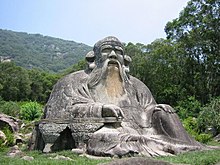لاوتسزی
لاوتسزی (بە چینی:老子) نووسەر و فەیلەسووفی چینی کەڤنارە وە کەسایەتییەکی کاریگەربوو لە بیروباوەڕی تاویزم.[١] لاوتسی نووسەری تێکستی کلاسیکی (تاو تی چینگ[تێبینی ١]) بوو.[٢]
| لاوتسزی | |
|---|---|
 | |
| 老子 | |
| لەدایکبوون | سەدەی 6 پز ویلایەتی چوو |
| مەرگ | سەدەی 5 پز چین |
| پیشە | فەیلەسووف، archivist، نووسەر، Taoist |
| کارەکان | Tao Te Ching |
| مناڵ | Li Zong |
| باوان | |

تێبینیەکان
دەستکاری- ^ دەقێکی کۆنی کلاسیکی بنچینەیی و فەلسەفییە بۆ ئایینی تاویزم
سەرچاوەکان
دەستکاری- ^ «Lao-tzu – Founder of Taoism». en.hubei.gov.cn. Government of Hubei, China. لە ڕەسەنەکە لە ٢٠ی تەممووزی ٢٠١٩ ئەرشیڤ کراوە. لە ١٥ی تشرینی دووەمی ٢٠١٨ ھێنراوە.
- ^ «Laozi». Stanford Encyclopedia of Philosophy. Stanford University. 2018.
The discovery of two Laozi silk manuscripts at Mawangdui, near Changsha, Hunan province in 1973 marks an important milestone in modern Laozi research. The manuscripts, identified simply as 'A' (jia) and 'B' (yi), were found in a tomb that was sealed in 168 BC. The texts themselves can be dated earlier, the 'A' manuscript being the older of the two, copied in all likelihood before 195 BC.
"Until recently, the Mawangdui manuscripts have held the pride of place as the oldest extant manuscripts of the Laozi. In late 1993, the excavation of a tomb (identified as M1) in Guodian, Jingmen city, Hubei, has yielded among other things some 800 bamboo slips, of which 730 are inscribed, containing over 13,000 Chinese characters. Some of these, amounting to about 2,000 characters, match the Laozi. The tomb...is dated around 300 BC.
| ئەم وتارە کۆلکەیەکە. دەتوانیت بە فراوانکردنی یارمەتیی ویکیپیدیا بدەیت. |
| کۆمنزی ویکیمیدیا، میدیای پەیوەندیدار بە لاوتسزی تێدایە. |